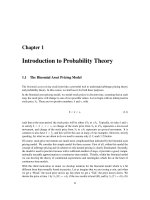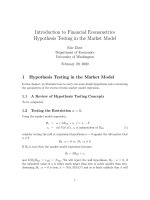Introduction To Molecular Biology -Salwa Hassan Teama M.D
Bạn đang xem bản rút gọn của tài liệu. Xem và tải ngay bản đầy đủ của tài liệu tại đây (2.29 MB, 59 trang )
Introduction To Molecular Biology
Salwa Hassan Teama M.D.
Contents
The Genome
The Cell
Eukaryotic Cell
Prokaryotic Cell
Three Domain of Life
The General Structure of Nucleic Acid
DNA
RNA
The Central Dogma of Molecular Biology
DNA Replication
From DNA to Protein
Genetic Mutation
Human genome project
Functional Genomics/Transcriptomics /Proteomics
Target Audience
Physician assistant;
Postgraduate in clinical specialties;
Medical students;
Medical technologist;
Beginners and
For every laboratory worker and everyone passion for
learning.
Dr./Salwa Hassan Teama 2012
Molecular Biology
Molecular biology; the branch of biology that study
gene structure and function at the molecular level.
The Molecular biology field overlaps with other areas,
particularly genetics and biochemistry.
The Molecular biology allows the laboratory to be
predictive in nature; events that occur in the future.
Dr./Salwa Hassan Teama 2012
The Genome Database
The genome database is organized in six major organism
groups:
Eukaryotes,
Bacteria,
Archaea,
Viruses,
Viroids and
Plasmids.
Dr./Salwa Hassan Teama 2012
Three Domain of Life
Eukaryotic
Prokaryotic
Archaea
Dr./Salwa Hassan Teama 2012
Eukaryotic Cell
Eukaryotes are generally
more advanced than
prokaryotes
Dr./Salwa Hassan Teama 2012
Eukaryotic Cell
Eukaryotic cells are found in animals, plants, fungi and
protists cell;
Cell with a true nucleus, where the genetic material is
surrounded by a membrane;
Eukaryotic genome is more complex than that of prokaryotes
and distributed among multiple chromosomes;
Eukaryotic DNA is linear;
Eukaryotic DNA is complexed with proteins called histones;
Numerous membrane-bound organelles;
Complex internal structure;
Cell division by mitosis.
Dr./Salwa Hassan Teama 2012
Prokaryotic Cell
Mariana Ruiz Villarreal, LadyofHats. Source: Wikipedia
Prokaryotic Cell
Unicellular organisms, found in all environments. These
include bacteria and archaea;
Without a nucleus; no nuclear membrane (genetic material
dispersed throughout cytoplasm;
No membrane-bound organelles;
Cell contains only one circular DNA molecule contained in the
cytoplasm;
DNA is naked (no histone);
Simple internal structure; and
Cell division by simple binary fission.
Dr./Salwa Hassan Teama 2012
Archaea
Archaea is prokaryotes;
organisms without nucleus
but some aspects of their
molecular biology are
more similar to those of
eukaryotes.
Dr./Salwa Hassan Teama 2012
Saperaud. Source: Wikipedia
The Genome
Totality of genetic information of an organism.
Encoded in the DNA (for some viruses, RNA).
Dr./Salwa Hassan Teama 2012
The Genome Size
Species/ Number of Chromosomes
Species Number of chromosomes
Human 46
Mouse 40
Rat 42
Fruit flies 8
Bacteria 1
Dr./Salwa Hassan Teama 2012
Human Genome
Human Genome; Arranged on multiple chromosomes;
twenty three pairs of chromosomes;
Twenty two pairs (autosomes).
One pair (sex chromosome) (xx) (female) or (xy)
(male).
Humans have 23 pairs of chromosome in every cell
(except mature red blood cells ); Gametes or sex cells
(sperm and eggs) have half the normal complement of
chromosomes.
Dr./Salwa Hassan Teama 2012
Human Genome
Jane Ades. Source: National Human Genome Research Institute
Modified from Strachan and Read . Source: />General Structure of Nucleic Acid
DNA and RNA are long
chain polymers of small
chemical compound called
nucleotides.
Dr./Salwa Hassan Teama 2012
Nucleotides
Nucleotides; ring shaped structures composed of:
Nitrogenous base; these bases are classified based on
their chemical structures into two groups:
Purine; double ringed structure (Adenine and Guanine).
Pyrimidine; single ring structures (cytosine and thymine).
Sugar
Phosphate group
Dr./Salwa Hassan Teama 2012
Nucleotides
DNA: Four different types of nucleotides differ in
nitrogenous base:
A is for adenine;
G is for guanine;
C is for cytosine and
T is for thymine.
RNA: thymine base replaced by uracil base.
Dr./Salwa Hassan Teama 2012
Nucleotides
Jypx35. Source: Wikipedia
The DNA
Deoxyribonucleic Acid (DNA); the genetic material
of all cellular organisms and most viruses.
DNA; the gigantic molecule which is used to encode
genetic information for all life on Earth.
A human cell contains about 2 meters of DNA. DNA
in the body could stretch to the sun and back almost
100 times. So it is tightly packed.
DNA responsible for preserving, copying and
transmitting information within cells and from
generation to generation.
Dr./Salwa Hassan Teama 2012
DNA Double Helix
Linked as a twisted ladder.
The curving sides of the ladder represent the
sugar-phosphate backbone of the two DNA
strands; the rungs are the base pairs.
Possess antiparallel polarity.
Stabilized by hydrogen bonds between the
bases.
Dr./Salwa Hassan Teama 2012
DNA Double Helix
Madprime. Source: Wikipedia
The Gene
The gene; it is a segment within a very long strand of
DNA.
Genes are the basic units of hereditary.
Genes located on chromosome on its place or locus.
Allele; a variant of the DNA sequence at a given
locus. Each allele inherited from a different parent.
Dr./Salwa Hassan Teama 2012
![[CEH V3] Introduction to Ethical Hacking](https://media.store123doc.com/images/document/13/ly/ap/medium_3ABUW8WdDH.jpg)








